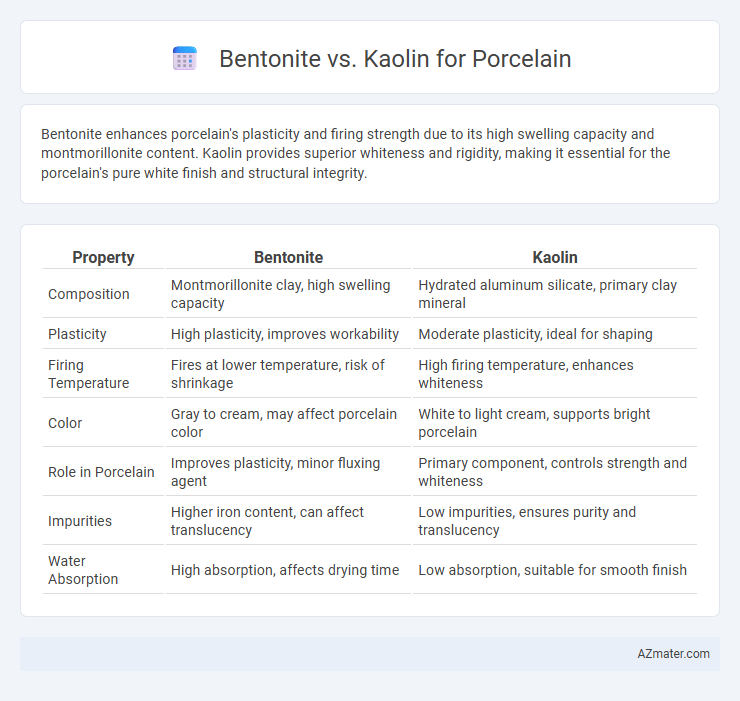Bentonite enhances porcelain's plasticity and firing strength due to its high swelling capacity and montmorillonite content. Kaolin provides superior whiteness and rigidity, making it essential for the porcelain's pure white finish and structural integrity.
Table of Comparison
| Property | Bentonite | Kaolin |
|---|---|---|
| Composition | Montmorillonite clay, high swelling capacity | Hydrated aluminum silicate, primary clay mineral |
| Plasticity | High plasticity, improves workability | Moderate plasticity, ideal for shaping |
| Firing Temperature | Fires at lower temperature, risk of shrinkage | High firing temperature, enhances whiteness |
| Color | Gray to cream, may affect porcelain color | White to light cream, supports bright porcelain |
| Role in Porcelain | Improves plasticity, minor fluxing agent | Primary component, controls strength and whiteness |
| Impurities | Higher iron content, can affect translucency | Low impurities, ensures purity and translucency |
| Water Absorption | High absorption, affects drying time | Low absorption, suitable for smooth finish |
Introduction: Understanding Bentonite and Kaolin in Porcelain
Bentonite and kaolin are essential clay minerals used in porcelain production, each contributing unique properties to the ceramic body. Bentonite, known for its high swelling capacity and plasticity, improves the workability and suspension qualities of porcelain slip. Kaolin, a primary ingredient in porcelain, provides whiteness, strength, and a smooth texture, making it crucial for achieving the characteristic translucency and durability of finished porcelain products.
Mineral Composition: Bentonite vs Kaolin
Bentonite is primarily composed of montmorillonite, a smectite clay mineral known for its high swelling capacity and plasticity, which enhances porcelain's workability and green strength. Kaolin consists mainly of kaolinite, a non-swelling clay mineral that provides whiteness, rigidity, and refractoriness to porcelain bodies. The distinct mineral compositions of bentonite and kaolin dictate their complementary roles in porcelain formulations, balancing plasticity and structural integrity.
Plasticity and Workability in Porcelain Bodies
Bentonite significantly enhances plasticity and workability in porcelain bodies due to its high swelling capacity and fine particle size, allowing better shaping and molding during forming processes. Kaolin, while contributing to porcelain's whiteness and fire resistance, offers lower plasticity and requires blending with plasticizers like bentonite to improve workability. Optimal porcelain formulations balance bentonite's plasticity with kaolin's refractory properties to achieve strong, smooth, and workable ceramic bodies.
Water Absorption and Shrinkage Properties
Bentonite typically enhances the plasticity of porcelain clay bodies, leading to lower water absorption due to its fine particle size and high swelling capacity, which improves vitrification. Kaolin contributes to porcelain's strength and whiteness but generally results in higher water absorption and greater shrinkage during firing because of its lower plasticity. Balancing Bentonite's plasticity and Kaolin's refractory properties optimizes porcelain's water absorption and shrinkage, achieving a durable, low-porosity final product.
Firing Temperature and Maturation Range
Bentonite enhances porcelain's plasticity and fires effectively between 1200degC and 1300degC, contributing to improved vitrification within this maturation range. Kaolin, essential for porcelain's whiteness and structure, matures at slightly higher temperatures, typically between 1250degC and 1350degC, offering stability and strength. Selecting bentonite or kaolin influences the porcelain's firing temperature and maturation dynamics, affecting durability and translucency.
Color and Opacity in Finished Porcelain
Bentonite enhances the plasticity of porcelain clay bodies but can slightly darken the color and reduce opacity due to its iron content, leading to a creamier finish. Kaolin, with its high whiteness and low impurities, contributes to brighter, more translucent porcelain, maintaining superior color purity and opacity. The choice between bentonite and kaolin significantly impacts the aesthetic quality, with kaolin preferred for achieving the classic bright white and translucent characteristics of fine porcelain.
Impact on Glaze Fit and Surface Quality
Bentonite enhances glaze fit on porcelain by improving suspension and particle distribution, reducing defects like pinholes and crawling, leading to a smoother surface finish. Kaolin, while offering excellent plasticity and contributing to the structural strength of porcelain, can cause glaze fit issues if used excessively due to its refractory properties that may interfere with glaze melting. Optimizing the balance between bentonite and kaolin ensures ideal glaze adherence and a flawless, glossy surface quality in porcelain products.
Cost and Availability of Bentonite vs Kaolin
Bentonite generally offers a more cost-effective option compared to kaolin due to its abundant global deposits and easier extraction processes. Kaolin, while slightly more expensive, tends to be less accessible depending on the region, influencing its availability in porcelain production. Manufacturers often choose bentonite to reduce production costs without significantly compromising the quality and performance of porcelain products.
Sustainability and Environmental Considerations
Bentonite and kaolin differ significantly in sustainability and environmental impact when used in porcelain production. Bentonite, a natural clay with strong water absorption properties, often requires less processing energy, reducing its carbon footprint compared to kaolin, which undergoes extensive refining to achieve the pure white color essential for high-quality porcelain. However, kaolin mining can lead to substantial landscape disruption and habitat loss, whereas bentonite extraction typically causes less environmental degradation, making bentonite a more sustainable choice in eco-conscious porcelain manufacturing.
Choosing the Right Clay: Recommendations for Porcelain Artists
Bentonite enhances porcelain's plasticity and increases drying strength, making it ideal for complex forms and wheel throwing, while kaolin provides whiteness and translucency essential for fine porcelain finishes. Porcelain artists should choose bentonite when working on intricate shapes requiring greater flexibility and use kaolin to achieve a smooth, pure white surface with a delicate translucency. Combining both clays in precise proportions optimizes workability and aesthetic quality in high-fired porcelain pieces.

Infographic: Bentonite vs Kaolin for Porcelain
 azmater.com
azmater.com